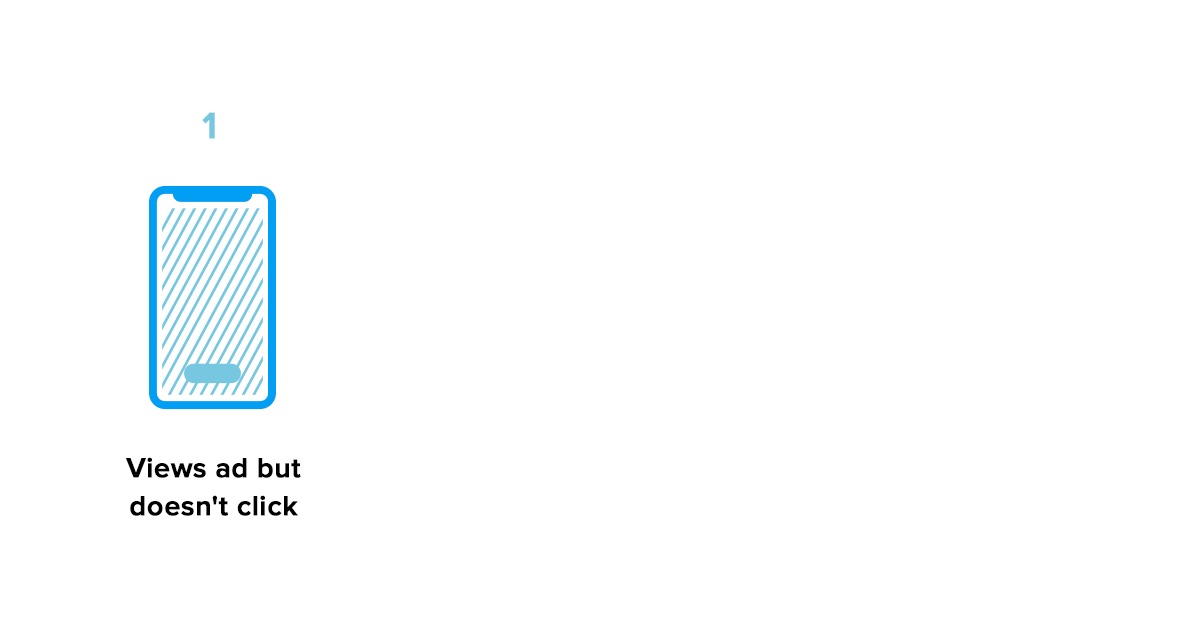Let’s say there’s a user who clicked on an ad and makes a purchase 30 days later. Did that ad drive the conversion? Was the ad so compelling that the user remembered to make a purchase 30 days later? It’s possible but not likely. It’s more likely that the user had seen other ads tens of not hundreds of times during those 30 days between the last click to purchase. The question now becomes, did the user make the purchase because of the ad they clicked on 30 days ago or because of the ads they saw (but did not click) during those 30 days?
For example, could it be that a user has seen an ad, but because he already knows the product, he decides to go directly to the app in order to make the purchase? In this scenario, the ad was not clicked, but it had a lift impact on the user ́s decision to make the purchase nevertheless.
With these questions in mind, the industry has been trying to better understand the user behavior by analyzing what happens before the purchase and even before the click on an ad.
The same way we call CTA “Click Through Attribution”, the attribution of a user to an ad that was clicked, we call VTA “View Through Attribution” the attribution of a user to an ad that was shown, but not clicked, by a user.
So what is VTA or View Through Attribution?
In one sentence: VTA is when you attribute a user to an ad impression without the user having clicked on it.

How does this affect advertisers’ spend?
If your business model is based on payment by last click, as most of the market today, your spend won’t be affected at all. For example, if you had spent USD100k in one month without using VTA and you decide to recalculate everything using VTA your final spent would still be the same USD100k.
So, what changes with VTA?
The only impact VTA will have on your campaign is on performance measurement. You are basically factoring in all the ads that were shown but not clicked on, to understand which impressions influenced app installs and conversions. This will ultimately result in a decrease in your CPA or an increase in your ROI.
But doesn’t this affect organics?
That is an excellent question. If we consider that an organic user is someone that has never been impacted by an ad impression, then VTA won’t do anything at all to your organics.
If your user has been impacted by an ad impression and then generates an event inside the attribution window, then and only then, will the event be attributed to the ad impression.
*Note that there is no debate that showing ads (even if not clicked) do have a real impact on people’s behavior, the discussion is generally around how much impact it has and for how long.
Why is it important to enable VTA?
There are many reasons why you should run or at least be able to analyze your data with the VTA input. One of these reasons is to understand if a partner, who seems to have a bad CPA, is performing poorly or if they’re actually generating a lift through impressions rather than clicks. For example, when evaluating a marketing partner you might see only 10 purchases a day with Last Click Attribution, and see the number of purchases for that same marketing campaign rise to 30 purchases when you activate VTA. Which would mean that 20 of your organic purchases, weren’t actually organic, but rather a result of users viewing your ads.
It’s important to note that VTA does not replace Last-Click Attribution. VTA works best when used in conjunction with Last-Click Attribution.
But what happens if the user sees an ad and later clicks on another ad from another partner before making the purchase?
There are two possibilities:. 1) The user clicked on the second ad after the attribution window of VTA expired or 2) the user clicked on the ad before the VTA attribution window expired. The click will always prevail, so in both cases, the event would be attributed to the ad that was clicked on.
How long are these attribution windows for VTA?
The standard time frame is 24h. This means if a user is impacted by seeing an ad, and acts on that “impulse” within 24hs (he/she installs, makes a purchase, books a trip, etc) this event is attributed to the ad impression. After this 24h window, the event becomes organic. In other words, outside the fixed window, it is assumed that the event had no relation with seeing the ad. Recent studies define specific VTA windows according to each business segment. Ranging from 24h down to a 1h attribution window for VTA. While the industry standard is 24hs, we encourage advertisers to test and determine the right attribution window for their app.
To learn more, contact us and stay connected by following us on LinkedIn.
